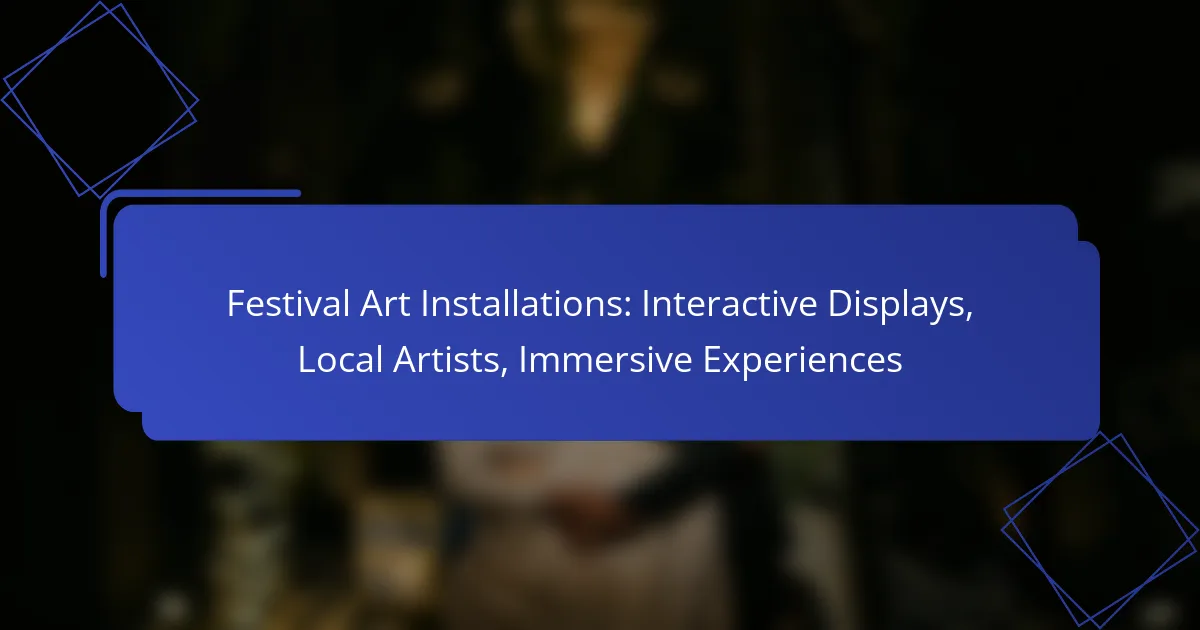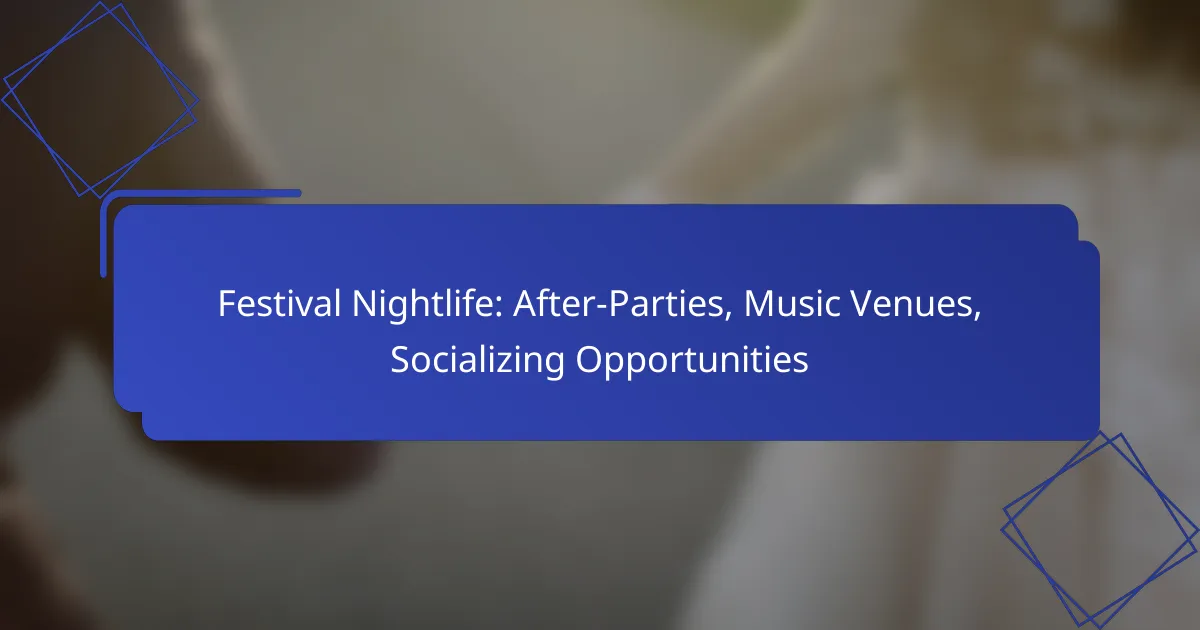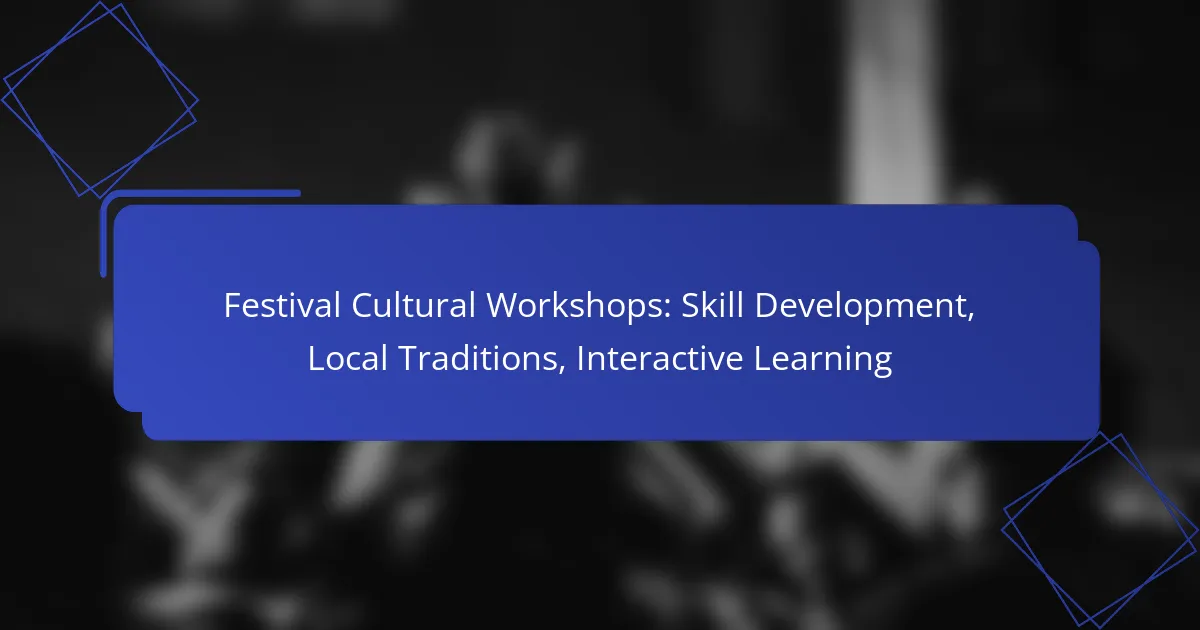Festival art installations in major US cities are a vibrant blend of creativity and local culture, featuring interactive displays that invite participation and engagement. These immersive experiences not only showcase the talents of local artists but also foster connections among attendees, making each festival a unique celebration of community and artistry.
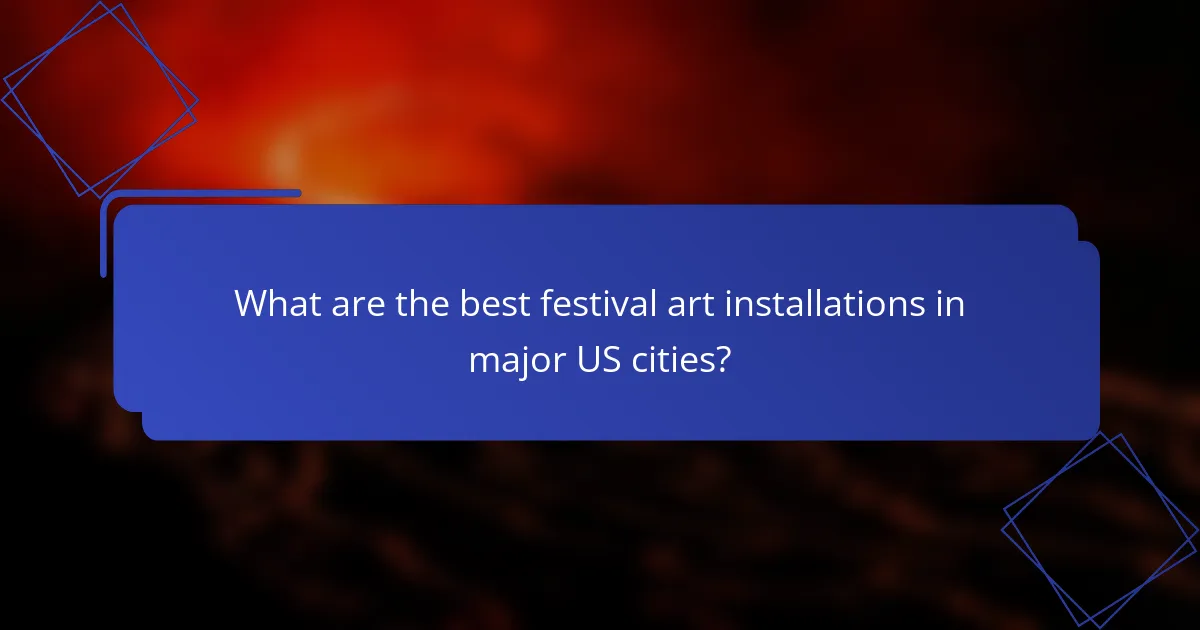
What are the best festival art installations in major US cities?
The best festival art installations in major US cities combine creativity, interactivity, and local culture. These installations often feature local artists and provide immersive experiences that engage festival-goers in unique ways.
Coachella Art Installations
Coachella is renowned for its large-scale art installations that enhance the festival experience. Artists create immersive works that often reflect themes of nature, technology, and social commentary. Notable installations have included giant sculptures and interactive pieces that invite audience participation.
Festival attendees should explore the art throughout the festival grounds, as many installations are strategically placed to encourage exploration and interaction. Engaging with these artworks can deepen the overall festival experience.
Burning Man Interactive Displays
Burning Man is famous for its avant-garde art installations, which are often interactive and designed to provoke thought and engagement. Artists create temporary structures that can be touched, climbed, or even transformed by participants, fostering a sense of community and collaboration.
Visitors should embrace the spirit of participation and creativity, as many installations invite contributions from attendees. This can include anything from adding to a communal art piece to participating in performances, making each experience unique.
New York City Immersive Experiences
New York City hosts a variety of festivals featuring immersive art experiences that captivate audiences. Events like the NYC Winter Lantern Festival and the Tribeca Film Festival often showcase installations that blend technology with artistic expression, creating engaging environments.
Festival-goers should look for installations that offer sensory experiences, such as light displays or soundscapes. These immersive elements can transform public spaces and encourage interaction, making the art accessible and engaging for all ages.
Los Angeles Local Artists
Los Angeles festivals frequently highlight the work of local artists through installations that reflect the city’s diverse culture. Events like the LA Art Show and the DTLA Art Walk feature works that often address social issues, community identity, and environmental themes.
Attendees should take the time to engage with artists and learn about their inspirations. This interaction can provide deeper insights into the cultural narratives represented in the art, enriching the festival experience.
Chicago Festival Art Highlights
Chicago’s festivals, such as the Chicago Blues Festival and Lollapalooza, often include impressive art installations that celebrate the city’s rich artistic heritage. These installations can range from large murals to interactive sculptures that reflect local history and culture.
Festival-goers should explore the art scene beyond the main stages, as many installations are located in less-traveled areas. Engaging with these works can reveal the city’s vibrant artistic community and enhance the overall festival atmosphere.
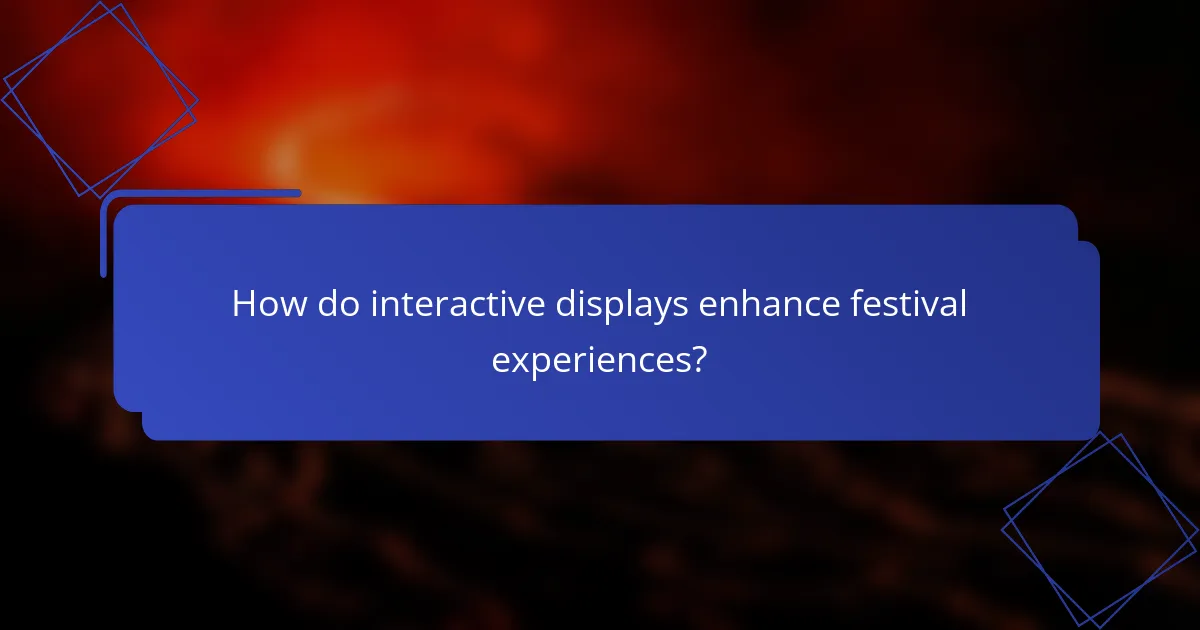
How do interactive displays enhance festival experiences?
Interactive displays significantly enhance festival experiences by engaging attendees in unique and memorable ways. These installations encourage participation, foster connections among visitors, and create immersive environments that resonate with the festival’s theme.
Engagement through Technology
Interactive displays utilize various technologies, such as augmented reality (AR), virtual reality (VR), and touch-sensitive interfaces, to captivate festival-goers. For instance, AR installations can overlay digital art onto physical spaces, allowing users to interact with their surroundings in innovative ways. This engagement not only entertains but also encourages social interaction as attendees share their experiences with others.
Moreover, the use of technology can provide real-time feedback, enhancing the overall experience. For example, installations that respond to movement or sound can create dynamic environments that change based on audience participation, keeping the energy high and the experience fresh.
Community Participation
Interactive displays often invite community participation, making festivals more inclusive and representative of local culture. By featuring local artists and their work, these installations allow attendees to connect with their community and support local talent. This can include collaborative art projects where visitors contribute to a larger piece, fostering a sense of ownership and pride.
Additionally, community-driven installations can reflect local issues or themes, encouraging dialogue and awareness among festival-goers. This participatory approach not only enhances the festival atmosphere but also strengthens community bonds.
Artistic Expression
Interactive displays serve as a canvas for artistic expression, allowing artists to push the boundaries of traditional art forms. By integrating technology, artists can create experiences that engage multiple senses, transforming static art into dynamic installations. This evolution of art encourages creativity and innovation, attracting a diverse audience.
Furthermore, these displays can be tailored to reflect the festival’s theme, enhancing the overall narrative. For example, an environmental festival might feature interactive installations that educate attendees about sustainability through engaging visuals and hands-on activities. This alignment of art and message amplifies the impact of both the artwork and the festival itself.

What local artists are featured in festival art installations?
Festival art installations often showcase a diverse range of local artists, highlighting their unique styles and perspectives. These artists create interactive displays and immersive experiences that engage festival-goers and reflect the cultural identity of the community.
Emerging Artists in Austin
Austin’s vibrant art scene is home to many emerging artists who contribute to festival installations. These creators often experiment with new media, incorporating technology and interactive elements to engage audiences. For instance, installations may feature augmented reality or soundscapes that invite participation.
Local festivals like South by Southwest (SXSW) provide a platform for these artists to gain visibility. Many installations are designed to be accessible and encourage interaction, making art a communal experience that resonates with the city’s creative spirit.
Notable San Francisco Creatives
San Francisco boasts a rich tapestry of notable creatives whose works are frequently featured in festival art installations. Artists here often draw inspiration from the city’s tech culture and social movements, resulting in thought-provoking pieces that challenge viewers’ perceptions.
Events such as the San Francisco Art Fair showcase installations that blend traditional art forms with cutting-edge technology. Artists may use projections, kinetic sculptures, or immersive environments to create experiences that are both visually stunning and intellectually stimulating.
Chicago’s Diverse Art Scene
Chicago’s art scene is characterized by its diversity, with artists from various backgrounds contributing to festival installations. This variety enriches the artistic landscape, offering festival-goers a chance to experience a wide range of cultural expressions and artistic techniques.
Festivals like the Chicago Blues Festival often feature installations that celebrate the city’s musical heritage. Artists may incorporate elements of performance art, live music, and visual storytelling, creating a dynamic atmosphere that invites audience participation and reflection on the city’s rich history.
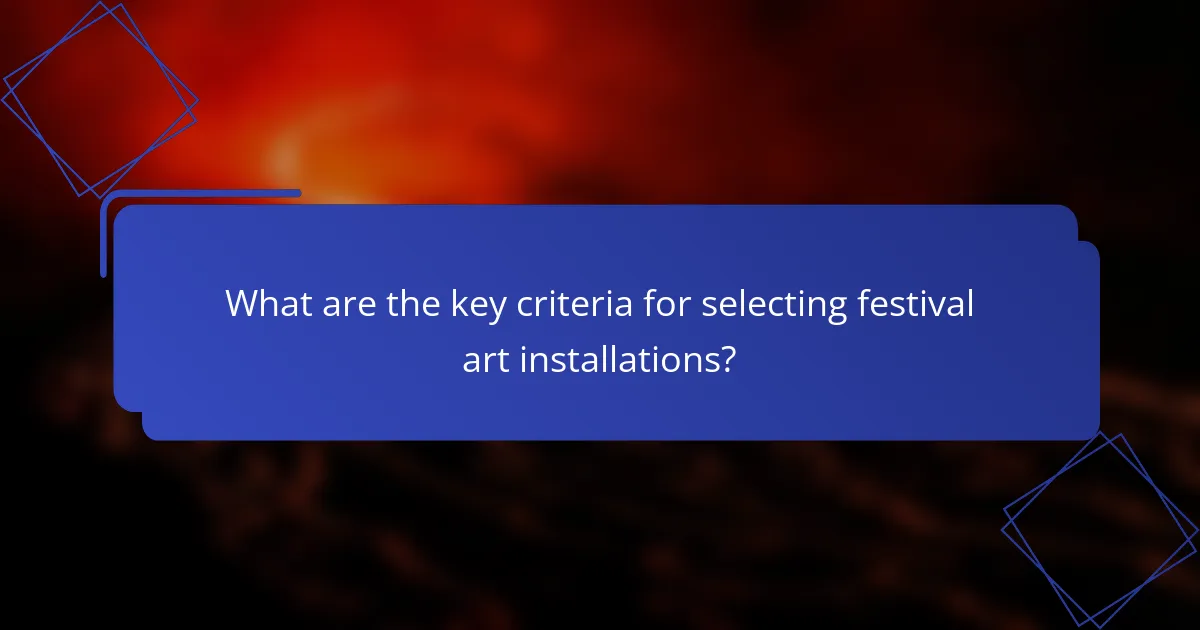
What are the key criteria for selecting festival art installations?
Key criteria for selecting festival art installations include audience engagement potential, artistic innovation, and logistical feasibility. These factors ensure that the installations not only attract visitors but also create memorable experiences while being practical to implement.
Audience Engagement Potential
Audience engagement potential is crucial for festival art installations, as it determines how well the artwork resonates with visitors. Interactive displays that invite participation, such as touch-sensitive elements or immersive environments, often draw larger crowds and foster deeper connections.
To evaluate engagement, consider the installation’s ability to provoke thought or evoke emotions. For example, installations that incorporate local themes or community stories can enhance relevance and encourage visitor interaction. Aim for installations that allow for varied levels of participation to cater to different audience preferences.
Artistic Innovation
Artistic innovation refers to the originality and creativity of the installation. Unique concepts or novel uses of materials can set an installation apart and attract attention. Festivals often seek out works that challenge traditional art forms, such as multimedia displays or eco-friendly installations that use sustainable materials.
When assessing artistic innovation, look for installations that push boundaries while still being accessible. Collaborations with local artists can also enhance creativity, as they bring fresh perspectives and cultural insights that resonate with the community.
Logistical Feasibility
Logistical feasibility is about the practical aspects of implementing an installation, including space requirements, safety regulations, and budget constraints. Ensure that the installation can be set up and dismantled efficiently, considering factors like transportation and installation time.
It’s essential to work within the festival’s budget and resources. For instance, installations that require extensive technical support or specialized equipment may not be viable. Always assess the installation’s maintenance needs during the festival to avoid disruptions and ensure a smooth experience for attendees.

How do immersive experiences impact festival attendance?
Immersive experiences significantly enhance festival attendance by creating engaging environments that attract larger crowds. These interactive displays and installations encourage participation, making festivals more appealing to a broader audience.
Increased Visitor Numbers
Immersive experiences can lead to a noticeable increase in visitor numbers at festivals. When attendees encounter unique and interactive art installations, they are more likely to invite friends and share their experiences, resulting in higher attendance rates. Festivals that incorporate local artists and innovative displays often see attendance boosts of 20-30% compared to traditional formats.
To maximize visitor numbers, festivals should promote these immersive experiences in their marketing efforts. Highlighting local talent and unique installations can attract both locals and tourists, enhancing the festival’s overall appeal.
Enhanced Social Media Sharing
Interactive displays encourage attendees to share their experiences on social media, amplifying the festival’s reach. Unique art installations often become photo hotspots, prompting visitors to post images and videos, which can lead to organic promotion and increased visibility online.
Festivals can enhance social media sharing by creating designated photo opportunities and encouraging the use of specific hashtags. Engaging with attendees online and featuring their posts can further boost the festival’s online presence and attract new visitors.
Memorable Visitor Experiences
Immersive experiences create lasting memories for festival-goers, which can lead to repeat attendance in future years. When visitors engage with interactive art, they form emotional connections that enhance their overall experience, making them more likely to recommend the festival to others.
To cultivate memorable experiences, festivals should focus on quality and creativity in their installations. Collaborating with local artists to create unique, culturally relevant displays can deepen the connection attendees feel, ensuring they leave with positive impressions and stories to share.
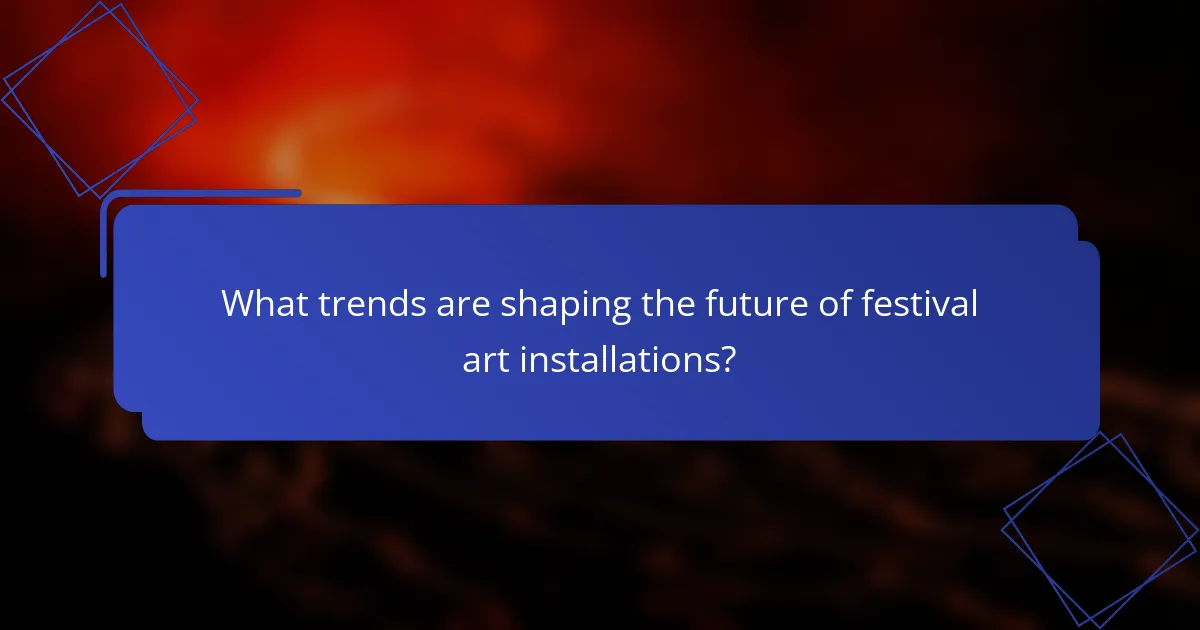
What trends are shaping the future of festival art installations?
Festival art installations are increasingly influenced by interactivity, local artist collaborations, and immersive experiences. These trends enhance audience engagement and create memorable, participatory environments that resonate with diverse attendees.
Interactive Displays
Interactive displays are transforming festival art by allowing attendees to engage directly with the installations. These displays often incorporate technology such as sensors, projections, and augmented reality to create dynamic experiences that respond to audience actions.
For example, installations may change colors or patterns based on movement or sound, fostering a sense of connection between the art and the viewer. Festivals like Coachella and Burning Man have successfully integrated these elements, making participation a key aspect of the experience.
Local Artists
Collaborating with local artists is a growing trend that enriches festival art installations. This approach not only supports the local economy but also reflects the cultural identity of the area, making the art more relevant and relatable to attendees.
Festivals often feature artists from the surrounding community, showcasing their unique perspectives and styles. This practice can lead to a diverse range of art forms, from traditional crafts to contemporary installations, creating a vibrant tapestry of local culture.
Immersive Experiences
Immersive experiences are at the forefront of festival art, drawing attendees into a multi-sensory environment. These installations often combine visual art, sound, and even scent to create a holistic experience that captivates the audience.
For instance, festivals may include themed areas where attendees can explore different artistic interpretations, engage in workshops, or participate in live performances. This trend encourages deeper emotional connections and lasting memories, enhancing the overall festival experience.
